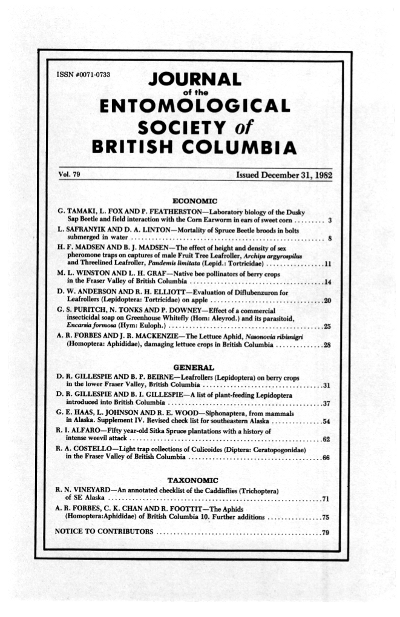Fifty-year-old Sitka spruce plantations with a history of intense weevil attack
Keywords:
Sitka spruce, <i>Picea sitchensis</i>, i>Pissodes strobi</i>, <i>Pseudotsuga menziesii</i>Abstract
The condition of 26 plantations of Sitka spruce (<i>Picea sitchensis</i> (Bong) Carr.) established between 1930 and 1935, at Green Timbers, Surrey, British Columbia, which sustained repeated attack by the white pine weevil (<i>Pissodes strobi</i> Peck) was examined in 1981. The plantations were started either as pure Sitka spruce or as a mixture of spruce and Douglas-fir (<i>Pseudotsuga menziesii</i> (Mirb.) Franco). A detailed survey was conducted in one plantation of each type for which annual infestation levels were recorded from 1936 to 1949 and which appeared to be typical of the rest of the pure and mixed plantations.
Many Sitka spruce trees were dead. having been out-competed by the other trees on the site as a result of repeated top-killing by <i>P. strobi</i>. Most surviving spruce trees were badly deformed, showed signs of severe attack, and were nonmerchantable. The plantation of pure Sitka spruce contained about 176 living Sitka spruce trees/ha, but only about 14 trees/ha were potential crop trees: the rest were suppressed or deformed. This plantation contained more volume in other volunteer conifers than in Sitka spruce. The mixed plantation developed into a merchantable stand of almost pure Douglas-fir, with only 5-6 Sitka spruce trees/ha.
References
Belyea, R.M. and C.R. Sillivan. 1956. The white pine weevil: A review of current knowledge. For. Chron 32:58-67.
British Columbia Forest Service. 1976. Whole stem cubic metre volume equations and tables. Forest Inventory Division, Victoria. B.C.
Furniss, R.L. and V.M. Carolin. 1977. Western forest insects. U.S. Dept. Agric, For. Serv. Mise. Pub. No, 1339. 654 pp.
Graham, K. 1951. The Sitka spruce weevil. Can. Dept. Agric., Science Serv. For. Biol. Div. Bi-Monthly Progress Report 7:3-4.
Graham, K., M.L. Prebble, W.G. Mathers, and D.N. Smith. (Undated). Unpub. rep., Pacific Forest Research Centre, Victoria, B.C. (File No. 1552).
Hopping, G.R. 1939. Project statement for project No. E. 30.41-1 “The Sitka spruce weevil, Pissodes sitchensis Hopk., Vernon and Vancouver, B.C., G.R. Hopping, W.G. Mathers and R.H. Longmore.” Unpub. rep., Pacific Forest Research Centre, Victoria, B.C.
Mathers, W.G. 1938. Annual report of the Vancouver Forest Insect Laboratory. Unpub. rep., Pacific Forest Research Centre, Victoria, B.C. 80 pp.
Mathers, W.G. 1939. Annual report of the Vancouver Forest Insect Laboratory. Unpub. rep., Pacific Forest Research Centre, Victoria. B.C. 119 pp.
L. H. 1976. Spruce weevil damage. Ecological basis and hazard rating for Vancouver Island. Environment Canada. For. Serv. Report No. B.C.-X-141.
Silver, G.T. 1961. Studies on the Sitka spruce weevil in British Columbia. I. Regional studies on the effect of the spruce weevil on Sitka spruce regeneration. Unpub. report. Pacific Forest Research Centre, Victoria, B.C. 14 pp.
Silver, G.T. 1968. Studies on the Sitka spruce weevil. Pissodes sitchensis in British Columbia. Can. Entomol. 100:93-100.
Wilson, D.A. and W.C. Robbins. 1969. Formulas and tables for point-sampling in forest inventory. Part 2: Metric system. Maine Agricultural Exp. Sta. Bull 680. 303 pp.
Wood, C. 1977. Cooley spruce gall aphid. Can. For. Serv. Pac. For. Res. Centre. For Pest. Leaflet No. 6. 2 pp.
Downloads
Published
Issue
Section
License
Authors who publish with the Journal of the Entomological Society of British Columbia agree to the following terms:
-Authors retain copyright and grant the journal right of first publication with the work simultaneously licensed under a Creative Commons Attribution License that allows others to share the work with an acknowledgement of the work's authorship and initial publication in this journal.
-Authors are able to enter into separate, additional contractual arrangements for the non-exclusive distribution of the journal's published version of the work (e.g., post it to an institutional repository or publish it in a book), with an acknowledgement of its initial publication in this journal.
-Authors are permitted and encouraged to post their work online (e.g., in institutional repositories or on their website) prior to and during the submission process, as it can lead to productive exchanges, as well as earlier and greater citation of published work (See The Effect of Open Access).


